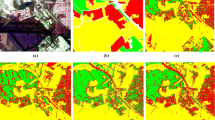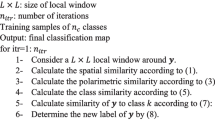Abstract
This paper proposes a technique for recognizing anthropogenic location objects on an underlying surface that is based on measuring the complete polarization scattering matrix (PSM) of a radiolocation scene. The intelligent analysis of a PSM implies the generation of adaptive robust estimates for trends and covariance matrices, as well as reflected non-stationary non-Gaussian signals. Based on the results of the digital computer simulation experiments and field measurements of the radiolocation scene’s PSM, machine learning algorithms for clustering and classifying the elements of an underlying surface and location object are verified. The possibility of using neural network architecture in the form of a support vector machine for real-time implementation of these algorithms is substantiated.












Similar content being viewed by others
REFERENCES
D. B. Kanareikin, N. F. Pavlov, and V. A. Potekhin, Polarization of Radar Signals (Sovetskoe Radio, Moscow, 1966) [in Russian].
A. Z. Kiselev, The Theory of Radar Detection on the Basis of Use of a Vector of Dispersion of the Purposes (Radio i Svyaz’, Moscow, 2002) [in Russian].
V. N. Tatarinov, S. V. Tatarinov, and L. P. Ligtkhart, Introduction to the Modern Theory of Radar Signals, Vol. 1: Polarization of Plane Electromagnetic Waves and Its Transformation (Tomsk. Univ., Tomsk, 2006) [in Russian].
D. Giuli, IEEE Trans. Antennas Propag. 74, 245 (1986).
Y. Yamaguchi, A. Sato, W.-M. Boerner, R. Sato, and H. Yamada, IEEE Trans. Geosci. Remote Sens. 49, 2251 (2011).
R. V. Ostrovityanov and F. A. Basalov, Statistical Theory of a Radar-Location of the Extended Purposes (Radio i Svyaz’, Moscow, 1982) [in Russian].
A. B. Borzov, G. L. Pavlov, V. B. Suchkov, et al., Elektromag. Volny & Elektron. Sist. 15 (1), 11 (2010).
A. B. Borzov, Millimetric Radar-Location. Methods of Detection and Targeting in the Conditions of Natural and Organized Hindrances (Radiotekhnika, Moscow, 2010) [in Russian].
A. B. Borzov, G. L. Pavlov, V. B. Suchkov, et al., Elektromag. Volny & Elektron. Sist. 15 (7), 27 (2010).
V. V. Akhiyarov, A. B. Borzov, and V. B. Suchkov, Elektromag. Volny & Elektron. Sist. 19 (3), 49 (2014).
A. B. Borzov, V. B. Suchkov, B. I. Shakhtarin, and Yu. A. Sidorkina, J. Commun. Technol. Electron. 49, 1356 (2014).
S. A. Aivazyan, I. S. Enyukov, and L. D. Meshalkin, Applied Statistics: Research of Dependences (Finansy i Statistika, Moscow, 1985) [in Russian].
A. M. Shurygin, Applied Stochastics: Robustness, Estimation, Forecast (Finansy i Statistika, Moscow, 2000) [in Russian].
S. R. Cloude and E. Pottier, IEEE Trans. Geosci. Remote Sens. 34, 498 (1996).
A. Freeman, Y. Shen, and C. L. Werner, IEEE Trans. Geosci. Remote Sens. 28, 224 (1990).
J. T. Tou and R. C. Gonzalez, Pattern Recognition Principles (Addison-Wesley, London, 1974; Mir, Moscow, 1978).
S. Khaikin, Neural Networks: Full Course, 2nd ed. (ID Vil’yams, Moscow, 2006).
Author information
Authors and Affiliations
Corresponding author
Additional information
Translated by Yu. Kornienko
Rights and permissions
About this article
Cite this article
Borzov, A.B., Labunets, L.V., Pavlov, G.L. et al. Recognition of Anthropogenic 3D Objects on an Underlying Surface by Intelligent Analysis of a Polarization Scattering Matrix. J. Commun. Technol. Electron. 65, 815–825 (2020). https://doi.org/10.1134/S1064226920060078
Received:
Revised:
Accepted:
Published:
Issue Date:
DOI: https://doi.org/10.1134/S1064226920060078




